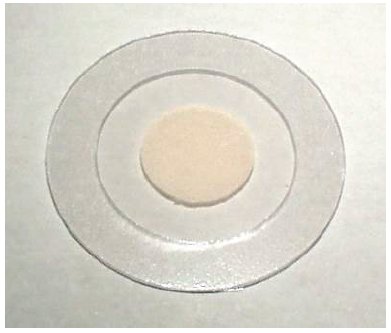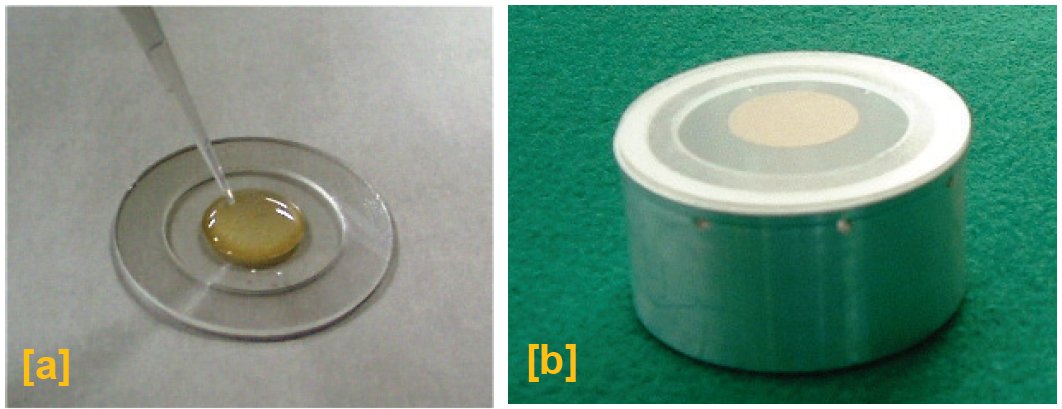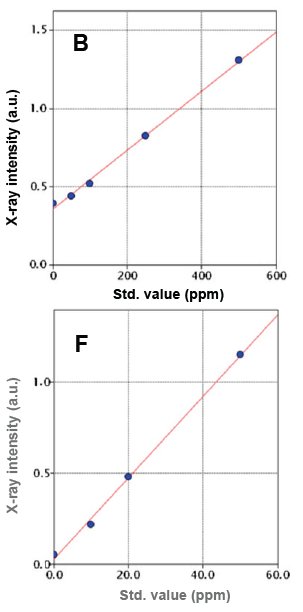Boron and Fluorine Quantitative Analysis for Water Solution by Micro-droplet Method using Ultra Carry Filter Paper
Introduction
When elements in a liquid are analyzed by X-ray fluorescence (XRF) spectrometry, the direct liquid analysis method, where a liquid sample is poured into a liquid cell with sample film and measured under helium, is usually used.
However, the wavelengths of the element lines of boron (B-Kα) and fluorine (F-Kα) are so long that they are absorbed by the sample film. This means that boron and fluorine in water cannot be analyzed by the direct liquid analysis method by XRF.
The microdroplet method using "Ultra Carry®" enables boron and fluorine analysis in water. Ultra Carry (Figure 1) is designed to analyze trace elements in water solution. Since the paper pad and film are very thin, the observed background during measurement is very low, which significantly improves the peak-to-background ratio (signal/noise). The paper pad captures water on the pad, which enables a drop of 500 μL at a time. After drying, the specimen is measured under vacuum. Since water analysis with Ultra Carry can be conducted under vacuum without sample film, boron and fluorine in water can be analyzed by XRF using Ultra Carry.
Ultra Carry and trace element analysis in water solution with Ultra Carry were introduced in Application Note (XRF1085). In this report, boron (B) and fluorine (F) analysis in water with Ultra Carry is demonstrated.

Figure 1: Photo of Ultra Carry
Sample and sample preparation
Standard solutions of boron and fluorine were diluted to make calibration standards.
On an Ultra Carry, 500 μL of each calibration standard was dropped (Figure 2 [a]) and dried overnight. The dried Ultra Carry was placed on a backscatter elimination cup made of aluminum (Figure 2 [b]) and then set into the sample holder of ZSX Primus IV. Since Ultra Carry is very thin, backscatter from the inside of the sample holder passes through it and is observed. The backscatter elimination cup blocks backscatter from the sample holder.
 Figure 2: Sample mountingfor Ultra Carry
Figure 2: Sample mountingfor Ultra Carry
[a] Drop 500 μL of the solution on the center (paper pad) of Ultra Carry
[b] After drying, place the Ultra Carry on the backscatter elimination cup (aluminum).
Instrument
The ZSX Primus IV, ZSX Primus IVi and ZSX Primus III NEXT are floor-standing sequential wavelength dispersive X-ray fluorescence (WDXRF) spectrometers, which have advantages in high spectral resolution and high sensitivity from light to heavy elements. The instruments are designed to provide reliable analysis results and their high flexibility provides versatility for a wide range of applications. These spectrometers are equipped with a Rh target X-ray tube. The maximum tube power is 4 kW for ZSX Primus IV / Primus IVi and 3 kW for ZSX Primus III NEXT, respectively. Up to 10 analyzing crystals can cover from beryllium to uranium.
Instrument control software provides inexperienced users with easy-to-use operation. The Flowbar system fully supports setting up qualitative and quantitative analysis.
Measurement
The ZSX Primus IV was used for measurement. The measurement conditions are shown in Table 1.
Table 1: Measurement condition
| Path atmosphere | Vacuum | |
| Analysis area | 30 mm diameter | |
| Element | B | F |
| Line | Kα | Kα |
| Tube condition (kV-mA) | 30-80 | 30-80 |
| Primary filter | Out | Out |
| Slit | S8 | S4 |
| Crystal | RX85 | RX26 |
| Detector | F-PC | F-PC |
| Counting time Peak (s) | 200 | 100 |
| Counting time BG (s) | 100 x2 | 100 |
Analysis results
Calibration curves of boron and fluorine in water using Ultra Carry were generated. The calibration summary and calibration curves are shown in Table 2 and Figure 3 respectively.
Table 2: Calibration summary (in ppm)
| Element | Calibration range | Accuracy | LLD |
| B | 0-500 | 14 | 8.4 |
| F | 0-50 | 1.2 | 0.4 |
The accuracy of calibration was calculated by the following formula:
$Accuracy = \sqrt{ \frac{\sum_i{(C_i-\hat{C}_i)^2}}{n-m} }$
$C_i$: calculated value of standard sample
$\hat{C}_i$: reference value of standard sample
n : number of standard samples.
m: degree of freedom (linear 2, quad. 3)

Figure 3: Calibration curve of boron and fluorine in water
To demonstrate reproducibility, three specimens of a water solution sample with ~250 ppm B and ~50 ppm F were prepared and quantified with the above calibration.
The test results are shown in Table 3.
Table 3: Reproducibility test result (in ppm)
| Element | B | F |
| n = 1 | 252 | 48.9 |
| 2 | 265 | 50.1 |
| 3 | 246 | 46.8 |
| Average | 254 | 48. |
| Range | 19 | 3.3 |
| Standard deviation | 11.4 | 2.0 |
| R.S.D. | 4.4% | 4.0% |
Conclusions
This report shows that a unique filter paper "Ultra Carry®" is applicable to boron and fluorine analysis in water. The LLD of boron and fluorine in water is 8.4 ppm and 0.4 ppm, respectively.
Since the water solution is dried on Ultra Carry, samples can be measured under vacuum. This means that, with Ultra Carry, it is possible to analyze from boron to uranium without needing helium gas.
Ultra Carry also enables analysis of trace elements lower than 0.1 ppm, or at ppb level, in water solution. Since sample preparation is very simple, it is possible to reduce analytical error derived from sample handling and also to shorten the total analysis time.

Contact Us
Whether you're interested in getting a quote, want a demo, need technical support, or simply have a question, we're here to help.
